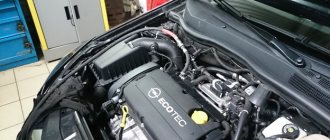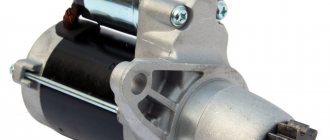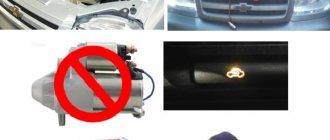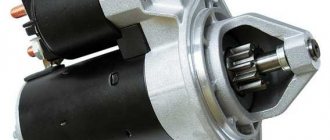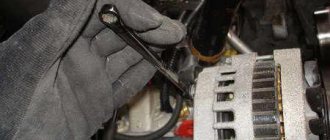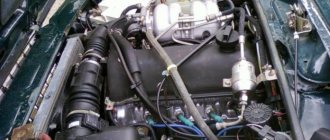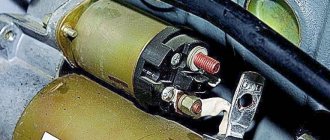I haven’t written anything for a long time, and there’s not much to write about. The squirrel is sick and is standing in the garage and
It is not clear what happened to her. All attempts to resuscitate passed
There were frosts, it was parked in the garage at the autostart and periodically warmed up,
but one fine day, the keychain told me I’ve had enough and refused
to start, I decided to try to start it with the key, but the starter only turns and that’s it!
What we tried: New spark plugs, new I/O wires, new distributor, there is a spark,
gasoline is flowing, turned off the alarm, checked the fuses,
poured gasoline into the cylinders, heated the spark plugs, heated the ignition coil, watered
boiling water on the manifold and injectors, dancing with a tambourine went on for 5 hours and all in vain,
The main reasons why a car won't start
If the Oka does not start, then, first of all, you should study the symptoms that appear. First of all, determine whether the starter turns. If it turns, what are its characteristics - does it work poorly, are there any sounds, and so on.
If necessary, you can try to start the car several times. If it does not turn over, then there are two reasons: a faulty starter or problems with the battery. In the first case, you need to contact a service station, and in the second, charge the battery, if possible, or change it altogether.
Some models have special protection in their design - a fuse. Finding it will not be difficult even for the most inexperienced driver. If the problem is a low battery, then the vehicle's electronics will not function fully. The most common case is terminal oxidation. To eliminate this, it is necessary to clean the terminals from dirt and oxidation elements. After this, you should carefully tighten the terminal fastening.
If there is a problem with the battery being completely discharged (for example, the headlights were on all night), it should be charged, unless we are talking about lead batteries. In the winter season, there are often frosts in many regions of our country. The car should be especially taken care of during this period. Many Oka owners take the battery home with them. Thus, being in a warm room, it will not discharge and the car will start without problems in the morning.
14.5. It won’t start - useful tips
| GENERAL INFORMATION |
Your technical equipment must be impeccable - after all, the time you have is the same money that, we hope, you also have. Don't lose either one or the other. If a missing tie out of nowhere or a pant leg burnt by an iron can cause a business meeting to be disrupted, what can we say about a car that doesn’t want to start an hour before the scheduled negotiations.
. Early in the morning, freshly shaved and full of great plans (child – to school, wife – to the hairdresser, and yourself – to forge a penny), you jump into the car, “key to start” and. What the hell. One more time. More. Nervous manipulations with the key and pedals do not bring success. The day is ruined from the very beginning. Plans and mood are down the drain.
Calm down. There is no need to rush under the hood in an English suit and, smearing the oily dirt with a tie, try to make a diagnosis. You probably won't be able to cure it in 5 minutes. Take another car, and leave the treatment of your sick friend until the evening. And it’s better to entrust it to doctors with a good reputation, especially if you have an expensive car and you are not a specialist. It will be cheaper this way. Well, if your friend is well known to you and you consider yourself a healer, well, try it yourself, if you’re not too lazy to get dirty or there’s no other way out.
The diagnosis must be made calmly
Mentally examine the symptoms. First, does the starter turn? And if so, how cheerful? You already know the answer - remember what happened the first time you tried to start the car. If you don't remember, try again.
If the starter does not turn at all and does not even click the traction relay when the ignition is turned on, then it is either faulty (you can close the hood and follow the advice given above: “Take another car.”), or there is a problem with the battery - it has turned off or died. Only in rare models can the starter power circuit be protected by a fuse - about 300 amperes - it is not difficult to find, especially if you know in advance where it is located. If the battery is to blame, then, as a rule, all electrical equipment does not work. The simplest and easiest case is that one of the terminals has come off or is dirty, but the battery is fine. Tighten the terminals on it and on the starter (if equipped). If it turns out that the battery is completely dead (forgot to turn off the headlights at night), you can still leave. But with outside help. Here, as they say, options are possible. You can try to start from a push, from a hill or from a tow. Don’t try to get around the pitfalls: a car with an automatic transmission or electronic fuel injection (if it has an electric fuel pump) will not be able to start using these methods. I'll have to light a cigarette at my neighbor's. However, for some machines this can lead to damage to the computer (read the instructions for the machine). If the starter turns on, but is sluggish (this happens in the summer, in winter this is a subject for a separate discussion), most likely the battery is almost completely discharged. This will be visible by weak headlights or weak signal. In this case, the above options for outside assistance come into play.
If the starter turns briskly, but the engine does not respond to attempts to start it, feel free to exclude everything related to the battery from further considerations. Blame the ignition or fuel supply system, you can’t go wrong. When diagnosing and treating each of them, a systematic approach is required. It’s better to start with the ignition - problems occur there more often. Especially in wet weather.
From a spark it will ignite.
So, we need to look for a spark. Your car may be equipped with a classic (simple) contact ignition system, a rather complex electronic contactless one, or some combination. In any case, the system consists of three parts. Part one is low-voltage (breaker contacts in a classic system or a special sensor in an electronic one, plus a box with electronic filling that forms a spark). Part two is a step-up transformer, called an ignition coil in the world. Part three is high voltage (mechanical or electronic distributor and wires through which high voltage current is supplied to the spark plugs). And of course, the candles themselves. The inspection of this entire enterprise must be carried out in stages and it is better to start from the end.
Stage one
. High voltage part of the system. Check to see if there is a spark on the center wire - this is the one that connects the coil to the distributor. The tip of the wire must be removed from the distributor cap, brought closer to any part that has good contact with the body of the car (it doesn’t matter whether it is painted or not), and secured so that there is a gap of 5–7 mm between the tip and the selected part.
If your car has an electronic ignition, the wire must be fastened especially securely - if it falls on ground, the electronics will instantly die. For the same reason, you should not scratch the wire across the body. We also do not recommend holding it with your hand, not even with your own - it will give you a serious electric shock.
Cooling system
The job of cooling is to maintain a stable temperature in the engine. The system consists of several nodes. The main problems with lack of cooling are as follows:
- Presence of cracks in the pipes.
- Unstable thermostat operation.
- Pump malfunction.
- Radiator honeycomb clogged.
- Unstable operation of the temperature sensor.
When the pump fails, uncharacteristic sounds appear in the engine. Traces of oil leaks are also formed. This problem can be solved by replacing the cooling system.
Clogged radiator honeycombs lead to improper heat exchange operation. Because of this, the engine may overheat greatly and subsequently not start at all. The situation can be corrected by thorough washing. However, if this does not help, then the elements of the cooling system are replaced.
Chevrolet Lanos will not start: causes and solutions to the problem
Chevrolet cars have powerful, economical engines that are equipped with fuel injection and have many advantages.
However, there are times when a breakdown is detected in the electronic control system and the car does not move. If the Chevrolet Lanos does not start, the reasons may be different, so you need to learn how to calculate the symptoms that are most often encountered when the engine malfunctions. If you can fix the problem yourself, it will save your money and nerves.
First of all, you need to calm down and focus on the causes of the problem. Listed below are simple problems that you can easily fix in minutes, as well as complex ones.
The latter are difficult to solve on your own, and you may need to go to a service station.
- 1 Situations with a simple solution
- 2 Difficult situations
Situations with a simple solution
- When a Chevrolet Lanos seizes but does not start, first of all, you need to make sure there is fuel; the reason can only be that you forgot to add fuel to the gas tank.
If this situation arises on the road, and you have nowhere to fill the tank, try the following: pour some water into a thick plastic bag, tighten it tightly, weaving a strong thin rope into a knot. Gradually pass it through the neck while not letting go of the rope.This will help increase the volume of fuel and bring the vehicle, despite the dimensions of the Chevrolet Lanos, to the service station.
- The next reason could be a low battery charge.
You can understand this by looking at the dashboard - the lights will glow dimly, and when you try to start the engine, they will turn off. The problem may be a wire that has come loose from its terminal.
Difficult situations
If the problem is not in the above points, then the reason may be much more complex
If changes in sound are heard, then you need to pay attention to the electrical system
The terminals on the battery may have oxidized, causing the starter to not receive enough current to start. To solve this, you need to clean the terminals to bare metal.
When you do not hear a click, this indicates a faulty retractor device, which is located in the starter.
You should also check the ignition system. First of all, you need to check the ignition coil, distributor, spark plugs and switch. If there is water on them, wipe it off with a cloth.
If a Chevrolet Lanos starts and stalls, the reason is most likely a malfunction of the electronics or fuel system. In the second case, you will not be able to do without a professional scanner, but in the first case, you need to make sure that the fuel pump turns on when you turn the key.
Remove the inlet hose from the fuel filter and turn the key again. If you do not hear a strong stream of fuel, then you should buy a new part.
It is also worth checking the fuel; add a little bit of it to the tank; if it is thick and does not spread, it means that you have chosen the wrong fuel for your climate.
The main reasons why there is no spark
- problem with spark plugs (flooded or faulty);
- breakdown of high-voltage wires or loss of contact;
- the reason is the crankshaft sensor (requires checking with a multimeter);
- malfunction in the ignition module;
- failure of the ignition coil;
- problem in the switch;
- Distributor malfunction (burned contacts, loss of clearance);
- poor ground wire contact;
- failure or malfunction of the ECU;
The spark is gone, what could it be?
price 5000r (normal BARGAIN!!)
89636851666″ title=”selling 4 wheels with tires! stampings r14 tires TRAYAL 185 65 r14 velcro rolled 1 season standard condition all 4 wheels are balanced
price 5000r (normal BARGAIN!!)
89636851666″> Buy - sell Oka
all this is nonsense in my mind and with all the desire on the stock engine 33. Kiryukha
HE also takes aim specifically bitch Irisha
2013 Morko О|оь Contacts
As you know, for an engine to operate, two conditions are necessary: the presence of fuel and a spark to ignite it. In cases where the spark disappears, starting the power plant becomes impossible.
This applies to a situation where the spark disappears completely, but there may be no spark on individual cylinders, when the engine begins to trip, there is an unstable start, a decrease in dynamics and power against the background of increased fuel consumption.
The situations are different, as are the troubleshooting paths.
9 reasons why there is no spark at all:
Spark plug
The electrodes of the spark plug may become covered with an oil coating, carbon deposits may appear, sometimes completely closing the gap between the electrodes, an insulator breakdown may occur, the electrodes will burn out and the spark plug will fail.
Ignition coil
There may be an interturn short circuit in the ignition coil or a winding break.
Distributor distributor
The distributor may have faulty contacts, a Hall sensor, a broken slider, or a crack in the cover.
Egnition lock
The contact group in the ignition switch may be faulty (burning of contacts, melting of the plastic protrusion that controls the switching of contacts.
High voltage wires
The problem in the wires can be expressed in their cracking, burning of the internal core and breakdown of the external insulation.
Hall Sensor
In a contactless ignition system, the Hall sensor is responsible for interrupting the spark, failures of which are often caused by the loosening of its mounting bolts, or a breakdown of the sensor itself.
Crankshaft sensor
If the DCV fails or there is poor contact in the connection with the sensor, the engine will not start even if there is a spark in the ignition system. It is necessary to check the connection or replace the sensor.
ECU
If there is a failure in the electronic engine control unit, there may also be no spark and it is necessary to carry out computer diagnostics of the unit.
Engine weight
Ground wire – poor contact or broken connecting wire.
Procedure for checking the ignition system
In order to understand in what order it is necessary to start checking the system, let us briefly recall how it works.
Scheme of operation of the classic ignition system
When the key is turned to the “ignition” position, power is supplied through an additional lock relay to one of the terminals of the low-voltage primary winding of the ignition coil. The coil has two low-voltage terminals; from the second terminal, the coil is connected through a wire to the terminal of the distributor.
Increased fuel consumption
– check the diaphragm of the fuel pump - its damage leads to gasoline entering the engine crankcase;
– tighten all clamps and threaded connections of the fuel system;
– check the vehicle's driving resistance. A VAZ-1111 at a speed of 50 km/h must cover a distance of at least 500 m before stopping. If this does not happen, then check the pressure in the wheels, the angles of the front wheels and the operation of the brake system (it may be jammed);
– adjust the carburetor, check the throttle valve, jets, needle valve;
– possible wear or damage to valves and piston rings.
The engine only runs on choke, why?
Why does a warm engine only run on choke?
Because either the fuel mixture supplied to it is too lean, which does not allow it to develop the required power and, accordingly, maintain the idle speed within 600-800 rpm, or there is a violation of spark formation on the electrodes of the spark plugs, leading to incomplete or untimely combustion of the fuel mixture, which is so also affects its power performance.
The “choke” handle extended towards itself allows you to close (partially or completely) the carburetor air damper, which ensures forced enrichment of the fuel mixture by reducing the proportion of air in it and maintaining minimum idle speed.
The reasons for the engine running only on choke are related to the carburetor and the power system
Using the example of engine 21083 of VAZ 21083, 21093, 21099.
The carburetor idle system (IAC) does not work
The fuel mixture does not enter the engine when the vehicle is idling, either at all or only partially. Reasons: the CXX is completely clogged, the CXX fuel jet is clogged, the solenoid valve or the EPH system is not working, the correct position of the throttle valve of the 1st chamber or the carburetor air damper is not correct.
Read more about how to diagnose and troubleshoot the idle system of the Solex carburetor 2108, 21081, 21083: “The idle system of the Solex carburetor does not work.”
The fuel pump does not pump
The supply of gasoline to the carburetor is disrupted; the fuel mixture at the outlet is lean. Reasons: fuel system filters are clogged (in the fuel pump, fine fuel filter, filter on the fuel intake in the gas tank), the fuel pump valves are faulty, the fuel pump drive is not adjusted (the pusher is worn out).
Damaged engine power system
Fuel from the gas tank is supplied in incomplete quantities or not at all. Reasons: system filters are clogged, the fuel intake in the fuel tank is clogged, fuel lines are damaged (broken, deformed).
“Suction” of foreign air into the carburetor
Excess air entering the fuel mixture through leaky carburetor seals leans the fuel mixture. Possible places for excess air to “suck in” are the gasket under the carburetor, the rubber o-ring on the fuel mixture “quality” screw, the o-ring on the EMC.
How to deal with this malfunction and find the place of the “suction”: “Suction of foreign air into the carburetor.”
The reasons for the engine running only on choke are related to the ignition system
The ignition timing is incorrectly set
Ignition that is too early or, conversely, too late does not allow timely ignition of the fuel mixture in the combustion chambers. In this case, the resistance to rotation of the crankshaft increases to such an extent that the engine can start and operate only on “choke”, which makes it possible to somehow compensate for the loss of power by additionally enriching the fuel mixture.
Parts of the ignition system are “broken”
A short circuit in the elements of the high-voltage circuit of the ignition system (spark plugs, high-voltage wires, distributor cover) leads to a disruption in spark formation on the spark plug electrodes. The spark periodically disappears and its strength decreases. This does not allow the fuel mixture to be effectively burned and the engine to reach the required idle speed. Power losses can only be compensated by forced enrichment of the fuel mixture by pulling the “choke” handle towards you.
The timing belt jumped or was installed incorrectly during replacement (the position marks of the camshaft and crankshaft have shifted relative to each other).
Specifications
Universal body parameters help position the car in any parking space. The minimum dimensions of the car contribute to this, namely:
| Width | 1.420 mm |
| Length | 3.200 mm |
| Height | 1.400 mm |
| Turning radius | 4.6 meters |
| Wheel base | 2.180 mm |
| Rear track | 1.200 mm |
| Front track | 1.210 mm |
| Clearance | 160 mm |
Other problems
The starter works and clicks, but the engine cannot start? The problem may be excess moisture under the hood. All you need to do is move the car to a place where there is no moisture and dry it. If the engine started, the problem was excess moisture. All that remains is to determine where the moisture came from and try to eliminate the problem.
It is likely that the on-board computer is generating an error. To fix the problem, it is important to conduct a full diagnosis and, if necessary, install new firmware. Then try to start the car again.
Finally, the problem may be in the crankshaft. The shaft itself may give incorrect signals about its position, and the on-board computer, in turn, will make incorrect fuel supply calculations. Result: the starter will rotate, with a characteristic clicking sound, but there will be no result.
So, the starter works and turns, but the car refuses to work and will not start. You can use the advice from the article, or don’t worry and contact a quality car service center.
Ignition system problems
Ignition involves supplying a spark using spark plugs to ignite the fuel mixture. If the problem lies in this system, then you can detect unstable operation of the engine (due to the fact that 1 or more cylinders are not working) and a decrease in energy.
It is recommended to check the spark plugs from time to time. There may come a time when the candles have already failed. Then the car will not start due to problems with the engine. The situation can be corrected by replacing all existing spark plugs.
Late and early ignition
With late ignition, combustion of the air-fuel mixture occurs throughout the entire power stroke. When the intake valve opens, the burning old mixture ignites fresh fuel. The engine overheats significantly during such operation. Popping noises can be observed not only in the carburetor, but also in the muffler.
For diagnostics, it is recommended to check the set ignition timing and, if necessary, adjust it. Whitened spark plug electrodes serve as indirect evidence of late ignition.
If the spark appears too early, the fuel will not ignite in a timely manner. In this case, the intake valve does not have time to close, and the combustible mixture inside the intake manifold ignites.
Particular attention should be paid to the OZ if work was carried out to repair the ignition system. It is required to produce the moment of sparking. The ignition timing is adjusted by turning the distributor relative to the scale.
Main signs of malfunction
Each car has its own specific signs of malfunction. However, in most cases they are all quite similar to each other. The main reasons include the following:
- the engine does not work or works poorly;
- sensations of strong vibrations;
- strong heating of the motor;
- unnecessary, loud sounds when turning on the engine;
- the presence of interruptions and instability in the operation of the internal combustion engine;
- the engine “troits” (malfunction);
- The carburetor is firing.
General manifestation of the malfunction
Popping noises in the carburetor may appear under the following circumstances:
- after engine repair;
- there was an accident or a pothole on the road;
- tuning or simply adjustment of the carburetor was carried out;
- the car has high mileage.
In this case, a malfunction may occur in the following cases:
- when you press hard on the gas pedal;
- after parking, with a cold engine;
- on the go under load;
- when trying to start the engine.
Depending on the reason that caused the carburetor to shoot, popping noises can appear either abruptly or gradually, increasing in intensity daily. Operating a car when the engine sneezes into the carburetor, in addition to discomfort for the driver, can lead to the need for major engine repairs.
The smell of gasoline
– check the threaded fasteners and clamps on the fuel system hoses;
– inspect the oil dipstick; if there are traces of gasoline on it, then gasoline may be entering the engine crankcase through a faulty fuel pump diaphragm;
– adjust the carburetor trigger;
– check the gasoline level in the float chamber;
– tighten the fuel jets tightly;
– adjust the ignition timing;
– inspect the throttle valve, it may be jammed;
– use a compressor to check the pressure in the cylinders. The smell of gasoline can be caused by wear of valves, rings, seats and other elements.
The spark is gone, what could it be?
price 5000r (normal BARGAIN!!)
89636851666″ title=”selling 4 wheels with tires! stampings r14 tires TRAYAL 185 65 r14 velcro rolled 1 season standard condition all 4 wheels are balanced
price 5000r (normal BARGAIN!!)
89636851666″> Buy - sell Oka
all this is nonsense in my mind and with all the desire on the stock engine 33. Kiryukha
HE also takes aim specifically bitch Irisha
2013 Morko О|оь Contacts
As you know, for an engine to operate, two conditions are necessary: the presence of fuel and a spark to ignite it. In cases where the spark disappears, starting the power plant becomes impossible.
This applies to a situation where the spark disappears completely, but there may be no spark on individual cylinders, when the engine begins to trip, there is an unstable start, a decrease in dynamics and power against the background of increased fuel consumption.
The situations are different, as are the troubleshooting paths.
9 reasons why there is no spark at all:
Spark plug
The electrodes of the spark plug may become covered with an oil coating, carbon deposits may appear, sometimes completely closing the gap between the electrodes, an insulator breakdown may occur, the electrodes will burn out and the spark plug will fail.
Ignition coil
There may be an interturn short circuit in the ignition coil or a winding break.
Distributor distributor
The distributor may have faulty contacts, a Hall sensor, a broken slider, or a crack in the cover.
Egnition lock
The contact group in the ignition switch may be faulty (burning of contacts, melting of the plastic protrusion that controls the switching of contacts.
High voltage wires
The problem in the wires can be expressed in their cracking, burning of the internal core and breakdown of the external insulation.
Hall Sensor
In a contactless ignition system, the Hall sensor is responsible for interrupting the spark, failures of which are often caused by the loosening of its mounting bolts, or a breakdown of the sensor itself.
Crankshaft sensor
If the DCV fails or there is poor contact in the connection with the sensor, the engine will not start even if there is a spark in the ignition system. It is necessary to check the connection or replace the sensor.
ECU
If there is a failure in the electronic engine control unit, there may also be no spark and it is necessary to carry out computer diagnostics of the unit.
Engine weight
Ground wire – poor contact or broken connecting wire.
Procedure for checking the ignition system
In order to understand in what order it is necessary to start checking the system, let us briefly recall how it works.
Scheme of operation of the classic ignition system
When the key is turned to the “ignition” position, power is supplied through an additional lock relay to one of the terminals of the low-voltage primary winding of the ignition coil. The coil has two low-voltage terminals; from the second terminal, the coil is connected through a wire to the terminal of the distributor.
Supply system
This component ensures the supply of fuel and air, preparation of the air-fuel mixture and filling of the cylinders with it. The key component of this system at Oka is the carburetor.
Malfunctions of the power system manifest themselves in the form of:
- Inability to start the engine;
- Business interruptions;
- Reduced engine power and response;
The cause of such malfunctions is the lack or supply of insufficient fuel, as well as severe clogging of the air filter or air leaks.
If gasoline is not supplied to the carburetor (you can check this by disconnecting the gasoline supply pipe from the carburetor and pumping fuel by manually pumping the pump), you should check the condition of the pipelines for leaks, as well as the condition of the membranes of the gasoline pump and fine filter. Sometimes, to eliminate the cause of the lack of gasoline supply, it is enough to simply unscrew the tank cap (if the atmospheric channel in it is clogged, a vacuum will be created in the tank, which will prevent the pump from pumping gasoline).
If fuel is supplied to the carburetor, we check the unit itself. It contains many channels of small cross-section, the blockage of which leads to the impossibility of starting the engine or interruptions in its operation. Flushing the carburetor and purging its channels often solves the problem, if, of course, it was related to the power system.
Failure of the idle speed solenoid valve, rupture of the starter membrane, incorrect idle speed adjustment , air leakage through the vacuum booster fitting or the gasket between the carburetor and the intake manifold are the reasons for unstable engine operation.
Why does the starter turn normally, but the engine does not catch and does not start?
In half the cases when a car refuses to start, the starter is to blame. At the same time, the other half occurs in situations where the starter regularly rotates the crankshaft, but the engine starts only after repeated attempts or is completely silent. This could be due to a variety of reasons.
Driver inattention or negligence
The notorious human factor can manifest itself in the most unexpected ways. For example, a banal lack of fuel or an alarm that blocks the fuel pump. It also happens that some “well-wisher” clogged the exhaust pipe, or a careless driver, while backing up, got stuck in a pile of soil or a snowdrift. Such reasons do not fall into the category of technical malfunctions, but they can spoil a lot of nerves.
Technical problems - starter malfunctions
Every more or less experienced driver will distinguish the sound of a starter, which regularly rotates the engine, from the useless buzz of its electric motor when there is no engagement with the flywheel. When starting to troubleshoot, you should definitely make sure that the starter is functioning normally, and that no extraneous knocks, clicks or malfunctions are observed during its operation.
Causes
The main reasons for this situation lie in the following motor components:
- fuel supply or ignition is stopped;
- the gas distribution mechanism adjustments have gone wrong;
- There was a breakdown of internal parts of the power unit.
Thanks to modern electronics, before a final breakdown, an alarm signal is displayed on the dashboard, which informs the driver about possible problems. At the first signal, it is worth immediately carrying out diagnostics and eliminating the malfunction at the initial stage.
If this is not done, then you can only wait for future problems, in which the engine suddenly stalls while driving, after which it does not start.
The starter turns the engine, but the engine does not start
Malfunctions that appear when the engine is started are a fairly common occurrence during vehicle operation, regardless of the type and design features of the installed power unit (gasoline, diesel, naturally aspirated or turbocharged engine, hybrid engine, etc.).
One of the most common situations is that after turning on the ignition and turning the key in the lock to the engine start position, the starter turns normally, but the engine does not start. A feature of this type of breakdown is a certain difficulty in localizing the fault. The fact is that it is much easier to look for a problem if, for example, the starter makes a sound but does not turn the engine, or the fuel pump does not pump after turning on the ignition. In any case, the existing problem needs to be solved. Next, we intend to talk about why the engine may not start when the starter turns the crankshaft well.
Irregularities in the fuel system
The operation of the Oka fuel system is to ensure that the mixture is supplied along with air and fills all cylinders with it. An important component that is responsible for the serviceability of this system is the carburetor. How can you identify problems with the fuel system?
The main reason for these problems is severe contamination of the air filters and lack of fuel mixture. If there is no gasoline supply to the carburetor, then first of all it is recommended to check the condition of the fuel pump, pipes, and cleaning filters for damage.
In some cases, it is very simple to correct the problems of poor fuel mixture supply. You should remove the cap from the fuel tank and look at the channel for blockages. If they are present in the tank, there will be a weak thrust for pumping fuel.
In the opposite situation, if fuel enters the carburetor, then the unit should be checked. It includes a large number of small channels, the blockage of which will lead to the inability to start the engine. Nevertheless, it is quite possible to solve this problem. The process of cleaning the carburetor and blowing through all channels will help resolve the situation.
Nissan Primera P12 won't start
Category: Car repair video
Vehicle characteristics: The dimensions of the car are as follows: length - 3467, width - 1100, height - 1228 mm. The wheelbase is 2224 mm. Ground clearance 223 mm. The car is equipped with a hybrid power unit.
The 4-cylinder engine is equipped with a system that provides engine power output. There are 4 valves per cylinder. The diameter of one cylinder is 76 mm, the piston stroke is 77 mm. The engine crankshaft accelerates to 2000 rpm.
Maximum torque is maintained up to 2000 rpm.
- Posted by admin: at the request of Alberic
- Views: 2224
- Watch the VIDEO about Nissan Example P12 not starting.
Rating of a car owner named Edna: Fast, convenient. In principle, as one of the predecessors wrote, there are not many cars of this size from 8 to 100 sq.m. What a bummer I was pleasantly surprised that the washer reservoir is located next to the antifreeze reservoir. It's going to get hot! Broken off completely.
The liquid freezes at once and the engine does not warm up (at -10 the water easily tolerated it). Here already at -5 there are problems. Conclusion - do not dilute the antifreeze at all. The headlights are narrow and they get clogged with dirt quickly (((The headlight washer helps, but very, very little. It’s impossible to drive with xenon headlights with dirty headlights.
The physics there is different, so for xenon the washer is mandatory. There is no need to turn off the washer. Moreover, it works from a separate button (which is hard to find by touch, and next to it there is a button for the gas tank lid - it’s not clearly thought out). I think they will definitely write to me that for 1.6 million it was possible to select a richer package, for example, from the Koreans same.
Indeed, the display is monochrome!!! It even made me laugh at first, but then I got used to it. On ebay, a colored one costs 250 bucks, from the officials - more than 100 thousand rubles. But I didn’t want Koreans, and I couldn’t find anyone with speakers like that.
It's important for me. Dynamics means safety and pleasure, and in the city too
And I’m sure the Japanese have higher reliability. In terms of consumption.
If you drive 90-100, the consumption is 8-9. 120-130 – 10.5-11. 150-170 – 16-17. Once I was driving frankly on the highway (up to 190 when overtaking) and the computer showed 18.7. I think it's quite realistic. The tank is more than 80 liters. In the city at an average speed of 23 km/h – 17-18 liters in winter. Basically a lot of expense. Rav ate five liters less.
But I myself chose a large engine and good dynamics for a heavy car. There was a breakdown. The power steering began to hum and was about to die. It's a shame. They replaced it without any fuss at the dealer. Why does he deserve credit? They also gave me a replacement car. What else? The eyeglass case is only big in appearance - it really doesn’t fit.
And they wrote about this a hundred times - every time the climate is switched, the air conditioner is forced to turn on. You will need to disable this function at the dealer. Sometimes the front brushes float. They try to adapt the speed of glass cleaning to the speed of movement. It doesn't always turn out to be on topic.
Original name: Tidak akan bermula Nissan La P12
Release date: 02.07.2022
Duration: 1:30
Quality: HD 720
Laughter in the topic: They risk their lives, driving in the oncoming lane, risk their license, avoiding traffic jams, risk their sanity, working from 5 am to midnight, and all so that you can get to work and home on time! They are minibus drivers - the most humble superheroes of our time.
How to start a car in winter
If the Oka does not start when cold, you should perform several actions:
- Carefully turn the ignition key to turn on electrical appliances.
- Take a break of a few seconds to allow all systems to prepare to turn on the engine. After this, you should turn the key all the way and hold it for no more than five seconds. If the Oka does not start and stalls, then you need to wait about a quarter of a minute and start the engine again.
- You can easily understand that it has started (by sounds and vibration). In the frosty season, it is recommended to turn the key to the indicator that electrical appliances are turned on and wait about a minute. Then turn on the ventilation, and then press the gas pedal about three times. The colder the engine, the longer it will take to start. The ventilation system does a great job of “waking up” the car, and pressing the gas pedal will clear the carburetor of excess gasoline.
Equilibrium mechanism
This mechanism is designed to reduce strong engine vibration. The design is quite strong and reliable. The main failure is a broken gear. The situation can be resolved by replacing the toothed disc.
As a result, it should be said that most of the above situations can be avoided if quality maintenance is carried out on the car and, in particular, the engine. The Oka is considered a rather capricious machine, so it is recommended to constantly monitor and care for it so that it is always on the move and helps out at the right time.
The appearance of popping noises in the carburetor is usually accompanied by unstable engine operation, floating idle speed, increased fuel consumption and the car losing its previous dynamic characteristics. In some cases, the engine does not start at all, or stalls immediately after starting, not responding to pressing the gas pedal.
Malfunctions
The simplified design of the ignition system and the absence of moving components ensures high reliability and ease of maintenance.
There are not so many malfunctions in the Oka ignition system:
- Switch failure;
- Hall sensor malfunction;
- Coil failure;
- Breakage or breakdown of wires, oxidation of contacts;
- Spark plug malfunction;
- Violation of the ignition timing;
Since the ignition system is directly involved in the operation of the engine, any malfunction in it immediately affects the performance of the engine - interruptions occur, the unit does not develop power, popping noises appear, or the unit simply does not start.
Diagnosis of a malfunction is carried out by visual inspection of the wiring and its connections, as well as by sequentially replacing all components with known good ones. A check using measuring instruments allows you to more accurately determine the faulty element.
The search for the problematic element is carried out from the candles. That is, first the presence of a spark is checked on them, then the high-voltage wires are inspected, and then the performance of the coil, switch, and Hall sensor is diagnosed.
The components of the ignition system are non-repairable, so if they break down they must be replaced.
Malfunction of the ignition distributor
A faulty distributor can cause improper ignition of the mixture in the combustion chamber. Its main faults include:
- breakdown of the lid;
- slider failure;
- oxidation at the attachment point of high-voltage wires, causing energy loss.
To identify the distributor as the culprit of the popping noise, it is recommended to install a known-good device in its place. If the shooting disappears, further diagnosis of the ignition distributor malfunction will be required.
Lubrication system
Provides lubricant supply to all rubbing surfaces. One of the most reliable systems due to its simplicity of design.
Its malfunctions manifest themselves in the form of a pressure drop, as a result of which a warning light lights up on the dashboard. Causes of malfunction:
- Pump wear;
- The bypass valve is blocked;
- Sensor malfunction;
- Clogged oil lines or network;
A worn pump and sensor will need to be replaced, and you can try flushing and clearing the bypass valve and clogged lines.
Typical causes of spark loss
Depending on the type of powertrain, there are several factors that can cause the spark plugs to fail to spark. In most cases the reasons are as follows:
- Low battery.
- Damage or failure of spark plugs. They can also be filled with gasoline or oil.
- Malfunction of the module, switch or ignition coil.
- Poor contact or damage to the insulating layer of high-voltage wires.
- Malfunction of the crankshaft position sensor (CPS).
- Malfunctions in the operation of the distributor.
- Problems in the low voltage circuit.
- Poor ground contact.
- Malfunctions in the operation of the engine ECU (electronic control unit).
We recommend: How to set up the StarLine alarm key fob: setting the time, enabling autostart and adjusting the volume
Video: why does your VAZ car not start, jerk, jerk, or stall?
Every owner of an Oka car has at least once encountered a situation where the engine does not start. Most problems appear in winter rather than in summer.
What to do in such cases? How to quickly eliminate the main cause of a malfunction? This article will talk about various reasons why the Oka does not start and how to solve them.
ATTENTION! A completely simple way to reduce fuel consumption has been found! Don't believe me? An auto mechanic with 15 years of experience also didn’t believe it until he tried it. And now he saves 35,000 rubles a year on gasoline! Read more"
Oka was produced for the first time in the Soviet Union at the Volzhsky plant. The car is classified as a passenger car. In total, about 700,000 copies were produced from different factories in Russia. Experts carefully tested the cars before they went on sale. They have been tested for stability, comfort, power and endurance in a variety of ways.
The starter turns, the car does not start: 6 reasons for the malfunction
The starter turns the car and does not start - a problem that can be confusing, because sometimes it is not clear what to do in this situation. And even though the starter clicks and turns, the car stands still. The article indicates the main causes of failure, as well as ways to get rid of them.
In order to deal with the problem, you need to find out its cause, so you will have to tinker. The first thing you need to understand is whether the starter is working or not. The fact that it spins does not mean that it is working and the car can be started easily.
It's easy to guess that problems with the starter can create difficulties on the road. Therefore, if the starter does not turn, it is important to get rid of this malfunction as quickly as possible.
So, there are two ways to solve the problem:
- fix the problem yourself;
- contact a car service center for help.
Undoubtedly, each method has its pros and cons. For example, to repair it yourself, you will need experience and skill. Although home repairs are cheap, there is no guarantee that everything will work, and there is a risk of completely ruining the part. Conversely, in a car service center, thanks to modern equipment and experienced personnel, it is possible to repair the relay in the starter. Considering that if the repair is unsuccessful, the part will need to be replaced with a new one, it will be more profitable to contact a car service center.
Don't waste your time - use the Uremont search and get offers from nearby services with specific prices!
How to check spark on ignition coil
To see if the coil is working at all, pull the wire from the breaker distributor that comes from the coil. The same test is carried out with it as with the spark plug wires, namely, they bring the wire to a distance of 0.5 cm and turn the starter. Now, regardless of the result, we can accurately talk about the cause of the breakdown.
In the first case, you need to check the contacts in the distributor-breaker for oxidation, insulation damage, and also check the serviceability of the rotor. If there is no spark due to it, the rotor must be replaced.
Checking the ignition coil
If, after checking, you realize that there is a spark in the car, but it does not start, then the ignition switch may need to be replaced.
The tester is cool, because . like an electrician, it’s as simple as three kopecks. He poked - there is no electricity, he poked even higher - there is no electricity, even higher - oh, there is! What do we have between the “pokes”? This is what is broken
Causes of car malfunction
Before making repairs, it is important to understand the cause of the breakdown. This is not always easy to do, so it is important to follow the exact sequence. It is necessary to check from small element to larger one, and so on until a reason is found why the starter does not engage and the car does not start. Here are the main reasons why movement is impossible:
- Faulty electronics.
- Clogged throttle valve.
- lack of gasoline or oil.
- Inoperative or clogged fuel pump.
- Damaged terminals on the battery or its discharge.
- Broken spark plugs or faulty injector.
These problems are quite simple, but they need to be given due attention. This way, you can understand whether you should seek help from a car repair shop, or take care of the problem yourself. If the inspection did not reveal any problems, and the vehicle still does not start, then it is better to seek help from a car service center.
The simplest reasons for engine failure to start were listed. But there are more serious breakdowns that prevent the car from starting. Unfortunately, it is almost impossible to immediately determine the breakdown. Finding and fixing problems will take a lot of time and skill.
Problems with the fuel system
Without fuel supply, the car will not move, the starter spins, but ignition does not occur (there is nothing to ignite). First of all, during ignition you need to listen to the pump. If it does not make noise during operation, then either the fuse has blown, there is no current, or the entire motor has burned out. Therefore, there are two ways: repair or buy a new element. If the problem persists, you need to look for the problem elsewhere.
Fuel filters
A fairly common problem why the starter does not engage is a clogged filter. Due to lack of fuel, the ignition process is impossible, as is the movement of the vehicle. All you need to do is simply change the fuel filter. Taking into account the fact that gasoline is far from being of the best quality, the impurities it contains will settle on the filter, which significantly reduces its service life.
Ignition
It is important to completely inspect the ignition system, because this is the main part that starts the car, be it an injector or a carburetor. On the injector, it is important to inspect and check the ignition module. To check, you need to put a cable on the removed spark plug and lean it against the engine. If there is no spark when starting the engine, the problem is in the module and it needs to be replaced. The same procedure is performed with the ignition coil on a carburetor engine. It would not be superfluous to check the condition of the spark plugs; if they are flooded, they need to be replaced. And at the end, you can diagnose the distributor. There should be no soot, chips or cracks on it.
Throttle valve
If the starter still spins but won't start, it's a good idea to check the throttle valves. If it is clogged, fuel will not flow well and will not be enough to ignite. All you need is some carburetor cleaner and a wire brush. After cleaning, everything needs to be blown out with compressed air. If the car has an on-board computer, then after cleaning the damper it is necessary to update the data. Since the computer itself sets the position of the damper based on the degree of contamination, this procedure should be performed after each cleaning.
The oil pressure light came on
If your oil pressure warning light comes on while driving, you need to stop immediately. Further driving may result in serious engine damage. After stopping, perform the following diagnostics:
– check the oil level on the dipstick;
– it is possible that oil of inappropriate viscosity has been filled in - replace it;
– remove the oil pan and check the oil receiver mesh (may be clogged) and the pressure relief valve for distortion, clogging or weakening of the spring;
– inspect the fuel pump diaphragm - if it is damaged, gasoline enters the oil, thereby diluting it;
– check the oil pump - it may be faulty due to wear on the gears;
Engine overheating
– plugs in the cooling system that occur due to leaks in the expansion tank cap. To check, apply soap suds to the lid and press the cooling system hoses with your hands; if soap bubbles appear, replace the tank or lid;
– excessive contamination of the radiator cells - wash the radiator with a stream of water;
– check the electric fan - connect it directly to the battery. If it works, then the sensor is faulty; if not, then check the electrical circuit or the fan motor;

